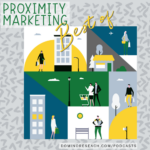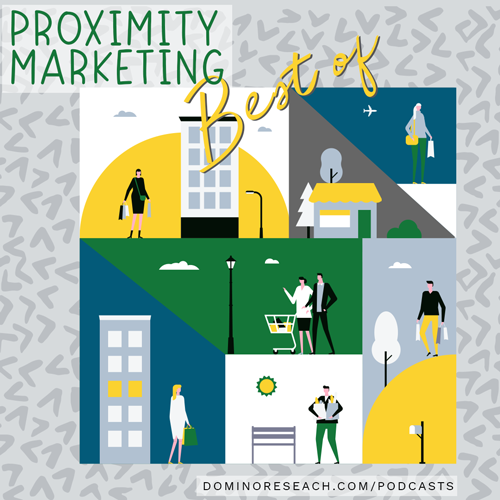
Don’t know proximity marketing? This episode is for you!
We know, it’s always something new and exciting in technology that you absolutely must keep up with, never mind trying to keep your day job and your side hustle going… really though, in all seriousness, proximity marketing is something that you need to know about, so you can make an educated decision about whether or not it’s something that might work for your business or branding efforts.
[LISTEN: Great podcasts for event planners – PODCAST EPISODE]
In this week’s podcast episode, we’ve compiled a series of clips from some of our older episodes that are targeted towards teaching you the high points and giving you some ideas about how you might best be able to use the iBeacons, especially in conjunction with the geo-location and geo-fencing features that the mobile wallet passes employ.
We’ve extracted some of the best moments from four different episodes, including our 50th episode, which details how a museum uses iBeacons to manage traffic flow and enhance user experience for attendees (talk about a captive audience for your proximity marketing!)
Realtors, real estate agents, and brokers, event planners, trade show organizers, and VIP hosts all have fantastic use cases for proximity marketing via mobile wallet campaigns, and we’re highlighting some of the most popular and effective uses of the technology across a variety of verticals and niches.
Knock, knock! Who’s there?
Proximity marketing relies on tiny radio transmitters that send signals to mobile devices, and cause a reaction – most often a lock screen notification or similar call to action. This means that customers or prospects are nearby (“near me” is the most popular appendix to a Google mobile search, and has been for years, think about that) and are in the mood to spend some money with you.
Find out about how geo-fencing, geo-location, and proximity can be linked together to create a simple but effective mobile campaign that more than 90% of prospects who initially opted in will be targeted, based on when they are near your business premises or event location.
Brick-and-Mortar Gets Tech-Savvy: Unveiling the Power of Proximity Marketing
In the age of e-commerce giants, brick-and-mortar stores are constantly seeking innovative ways to attract customers and compete. Proximity marketing emerges as a potent weapon in their arsenal. It leverages location-based technologies like Bluetooth and Wi-Fi to deliver targeted marketing messages directly to potential customers’ mobile devices – when they’re physically close to a store. Imagine walking past a clothing store and receiving a notification for a discount on a specific item you browsed online earlier. This is the magic of proximity marketing.
This technology offers a treasure trove of benefits for brick-and-mortar locations, breathing new life into the physical shopping experience. Let’s delve into some key advantages:
- Hyper-Targeted Marketing: Unlike traditional advertising with a broad reach, proximity marketing allows for laser-focused targeting. By understanding a customer’s location, stores can deliver relevant and timely messages. This can significantly increase the effectiveness of marketing campaigns and drive conversions.
- Boosting In-Store Engagement: Proximity marketing can entice customers who are already near the store. Imagine receiving a notification highlighting a special sale or exclusive in-store offer. This can nudge them to step inside, browse products, and potentially make impulse purchases.
- Building Customer Loyalty: Proximity marketing allows stores to personalize the shopping experience. Imagine receiving a welcome message as you enter the store or product recommendations based on your past purchases. These personalized touches can foster a sense of connection and loyalty with the brand.
- Data-Driven Insights: Proximity marketing platforms capture valuable customer data based on location and engagement. This data can reveal customer behavior patterns, dwell times in specific areas of the store, and even identify items that generate the most interest. By analyzing this data, stores can optimize their product placement, store layout, and marketing strategies for improved results.
- Enhancing the In-Store Experience: Proximity marketing can be used to create interactive experiences that bridge the gap between the physical and digital worlds. Imagine using your phone to access product information, reviews, or even augmented reality features that allow you to virtually try on clothes or visualize furniture in your home. This can make shopping more fun, informative, and engaging for customers.
However, implementing proximity marketing effectively requires careful planning. Here are some essential considerations:
- Customer Opt-In: Respecting user privacy is paramount. Customers must opt-in to receive location-based messages to avoid appearing intrusive.
- Value Proposition: Proximity marketing messages need to offer genuine value. Simply sending generic ads can backfire.
- Omnichannel Integration: Proximity marketing should be integrated with a broader omnichannel strategy, ensuring a seamless experience across online and offline channels.
Proximity marketing offers a game-changing opportunity for brick-and-mortar stores. By leveraging its hyper-targeting capabilities, personalized experiences, and valuable customer insights, stores can bridge the gap with online retailers, create a more engaging shopping experience, and ultimately drive sales and brand loyalty in a competitive retail landscape. As technology continues to evolve, proximity marketing has the potential to become an indispensable tool for brick-and-mortar stores to thrive in the digital age.

